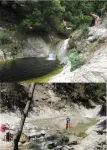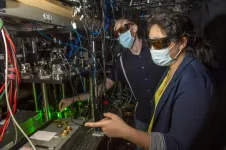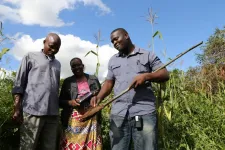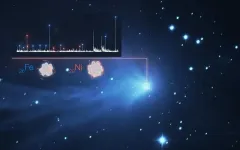(Press-News.org) By mapping its genetic underpinnings, researchers at University of California San Diego School of Medicine have identified a predictive causal role for specific cell types in type 1 diabetes, a condition that affects more than 1.6 million Americans.
The findings are published in the May 19, 2021 online issue of Nature.
Type 1 diabetes is a complex autoimmune disease characterized by the impairment and loss of insulin-producing pancreatic beta cells and subsequent hyperglycemia (high blood sugar), which is damaging to the body and can cause other serious health problems, such as heart disease and vision loss. Type 1 is less common than type 2 diabetes, but its prevalence is growing. The U.S. Centers for Disease Control and Prevention projects 5 million Americans will have type 1 diabetes by 2050. Currently, there is no cure, only disease management.
The mechanisms of type 1 diabetes, including how autoimmunity is triggered, are poorly understood. Because it has a strong genetic component, numerous genome-wide association studies (GWAS) have been conducted in recent years in which researchers compare whole genomes of persons with the same disease or condition, searching for differences in the genetic code that may be associated with that disease or condition.
In the case of type 1 diabetes, identified at-risk variants have largely been found in the non-coding regions of the genome. In the Nature study, senior author Kyle Gaulton, PhD, an assistant professor in the Department of Pediatrics at UC San Diego School of Medicine, and colleagues integrated GWAS data with epigenomic maps of cell types in peripheral blood and the pancreas. Epigenomic mapping details how and when genes are turned on and off in cells, thus determining the production of proteins vital to specific cellular functions.
Specifically, researchers performed the largest-to-date GWAS of type 1 diabetes, analyzing 520,580 genome samples to identify 69 novel association signals. They then mapped 448,142 cis-regulatory elements (non-coding DNA sequences in or near a gene) in pancreas and peripheral blood cell types.
"By combining these two methodologies, we were able to identify cell type-specific functions of disease variants and discover a predictive causal role for pancreatic exocrine cells in type 1 diabetes, which we were able to validate experimentally," said Gaulton.
Pancreatic exocrine cells produce enzymes secreted into the small intestine, where they help digest food.
Co-author Maike Sander, MD, professor in the departments of Pediatrics and Cellular and Molecular Medicine at UC San Diego School of Medicine and director of the Pediatric Diabetes Research Center, said the findings represent a major leap in understanding the causes of type 1 diabetes. She described the work as "a landmark study."
"The implication is that exocrine cell dysfunction might be a major contributor to disease. This study provides a genetic roadmap from which we can determine which exocrine genes may have a role in disease pathogenesis."
INFORMATION:
First author Joshua Chiou, PhD, a recent graduate of the Biomedical Sciences graduate program at UC San Diego added: "Understanding how type 1 diabetes originates at the cellular level is a critical step in finding treatments for reversing its course and, ultimately, preventing the disease altogether."
Co-authors include: Ryan J. Geusz, Mei-Lin Okino, Jee Yun Han, Michael Miller, Rebecca Melton, Elisha Beebe, Paola Benaglio, Serina Huang, Katha Korgaonkar, and Sebastian Preissl all at UC San Diego; David U. Gorkin, Emory University; and Sandra Heller and Alexander Kleger, Ulm University, Germany.
Boulder, Colo., USA: Deep pools below waterfalls are popular recreational swimming spots, but sometimes they can be partially or completely filled with sediment. New research showed how and why pools at the base of waterfalls, known as plunge pools, go through natural cycles of sediment fill and evacuation. Beyond impacting your favorite swimming hole, plunge pools also serve important ecologic and geologic functions. Deep pools are refuges for fish and other aquatic animals in summer months when water temperatures in shallow rivers can reach lethal levels. Waterfalls also can liquefy sediment within the pool, potentially triggering debris flows that can damage property and threaten ...
Florida State University researchers have more insight into a strange sea creature found in oceans around the world and what their presence means for the health of a marine ecosystem.
Scientists have thought that salps -- small marine organisms that look like clear, gelatinous blobs -- competed for resources with krill, shrimp-like creatures that are an important food source for many marine animals. But new research published in Limnology and Oceanography suggests that salps are actually competing for food with an organism known as a protist.
An image of a salp taken during research. New research published in Limnology and Oceanography suggests that salps are actually competing for food with an organism known as a protist. (Courtesy of ...
A heart surgeon doesn't need to grasp quantum mechanics to perform successful operations. Even chemists don't always need to know these fundamental principles to study chemical reactions. But for Kang-Kuen Ni, the Morris Kahn associate professor of chemistry and chemical biology and of physics, quantum spelunking is, like space exploration, a quest to discover a vast and mysterious new realm.
Today, much of quantum mechanics is explained by Schrödinger's equation, a kind of master theory that governs the properties of everything on Earth. "Even though ...
The amount of nutrients people get from the crops that they eat is a type of 'postcode lottery', according to new research that has analysed thousands of cereal grains and soils as part of a project to tackle hidden hunger in Malawi and Ethiopia.
A global team led by the University of Nottingham and its Future Food Beacon including academics and researchers from Addis Ababa University (AAU) in Ethiopia and Lilongwe University of Agriculture and Natural Resources (LUANAR) in Malawi, working on the GeoNutrition project, have discovered more about the relation between soils, crops and micronutrient deficiencies among people living there. Their ...
HERSHEY, Pa. -- Parkinson's disease is the second most common neurodegenerative disease and affects more than 10 million people around the world. To better understand the origins of the disease, researchers from Penn State College of Medicine and The Hebrew University of Jerusalem have developed an integrative approach, combining experimental and computational methods, to understand how individual proteins may form harmful aggregates, or groupings, that are known to contribute to the development of the disease. They said their findings could guide the development of new therapeutics to delay or even halt the progression of neurodegenerative diseases.
Alpha-synuclein ...
A new study by a Belgian team using data from the European Southern Observatory's Very Large Telescope (ESO's VLT) has shown that iron and nickel exist in the atmospheres of comets throughout our Solar System, even those far from the Sun. A separate study by a Polish team, who also used ESO data, reported that nickel vapour is also present in the icy interstellar comet 2I/Borisov. This is the first time heavy metals, usually associated with hot environments, have been found in the cold atmospheres of distant comets.
"It was a big surprise to detect iron and nickel atoms in the atmosphere of all the comets ...
Where you live may predict your long-term survival after experiencing a first heart attack. Socioeconomic factors -- such as income, education, employment, community safety and more -- have long been associated with cardiovascular health, but less is known about how neighborhood factors impact outcomes after myocardial infarction (MI), particularly among younger individuals. In an article published in JAMA Cardiology, researchers from Brigham and Women's Hospital and colleagues studied the health records of 2,002 patients who experienced an MI at or before age 50. They found that even after adjusting ...
What The Study Did: Researchers evaluated racial and ethnic diversity among obstetrics and gynecology, surgical and nonsurgical residents in the United States from 2014 to 2019.
Authors: Claudia L. Lopez, M.D., of the University of California, Davis, is the corresponding author.
To access the embargoed study: Visit our For The Media website at this link https://media.jamanetwork.com/
(doi:10.1001/jamanetworkopen.2021.9219)
Editor's Note: The article includes funding/support disclosures. Please see the article for additional information, including other authors, author contributions and affiliations, conflict of interest and financial disclosures, and funding and support.
# ...
What The Study Did: Registry data were used to examine the association between living in a socioeconomically disadvantaged area and long-term survival among patients who had their first heart attack at or before age 50.
Authors: Ron Blankstein, M.D., of Brigham and Women's Hospital in Boston, is the corresponding author.
To access the embargoed study: Visit our For The Media website at this link https://media.jamanetwork.com/
(doi:10.1001/jamacardio.2021.0487)
Editor's Note: The article includes conflict of interest disclosures. Please see the articles for additional information, including other authors, author contributions and affiliations, conflicts of interest and financial ...
What The Study Did: This study looked at the use of consumer digital information for COVID-19 control U.S. adults consider to be acceptable and the factors associated with higher or lower approval of using this information.
Authors: David Grande, M.D., M.P.A., of the University of Pennsylvania, is the corresponding author.
To access the embargoed study: Visit our For The Media website at this link https://media.jamanetwork.com/
(doi:10.1001/jamanetworkopen.2021.10918)
Editor's Note: The article includes conflict of interest and funding/support disclosures. Please see the article for additional information, including other authors, author contributions and affiliations, conflict of interest and financial disclosures, and funding and support.
# # #
Media advisory: ...



